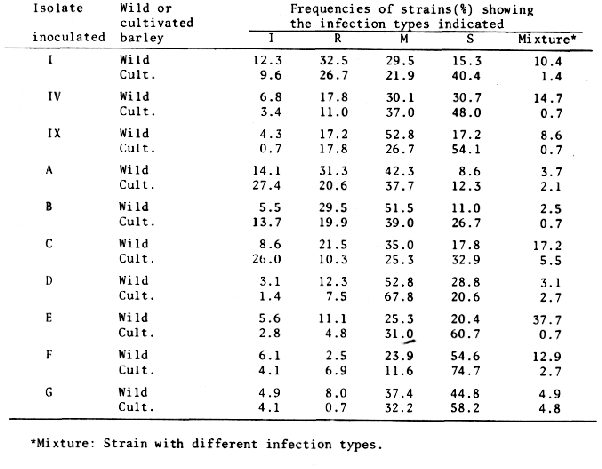

A total of 163 strains of wild barley, H. spontaneum C. Koch, originated from Afghanistan, Iran, Iraq,Turkey and Caucasus area in U.S.S.R., were tested for resistance to powdery mildew by Erysiphe graminis f. sp. hordei. Then, its variation of resistance was compared with that of 146 strains of cultivated barley collected in the same region. Ten different isolates of the parasite were used for inoculation. Three of them were the. most popular land races, I, IV and IX, in Japan, and the other seven isolates, named here tentatively 'A' to 'G' were originated from the artificial crossing between two Japanese races, IX and XIV. These isolates were separately inoculated onto the first leaves of the host plants, and the infection types were classified into the followings: I, immune-like; R, highly resistant; M, moderately resistant; and S, highly susceptible type.
Table 1 shows the frequency of each of four infection types in wild and cultivated barleys. Highly or moderately resistant strains with I, R or M infection type were most frequent among wild barleys, as compared with the cultivated forms. It was noteworthy that among these three resistant reactions, M type was most frequent in wild barleys. The frequency of strains showing mixed conditions with different infection types was also relatively higher in wild barley.
Next, the same experimental results were re-arranged in order to know how many mildew isolates to which each of the wild or cultivated strains showed resistant reactions (I, R or M). Table 2 shows the frequencies in per cent of the barley strains which were found to be resistant to different number of mildew isolates. As seen in this table, the frequency of strains resistant to all the ten isolates infested was 24% in wild barleys while it was only 6% in the cultivars. And, 63.6% of the wild barley strains were found to be resistant to 8 or more isolates, whereas such a highly resistant cultivars were only 25.5%.



Among the strains of H. spontaneum, those with moderate resistance to many different isolates may be useful for genetic resources of the resistance to powdery mildew because of their mild selection pressure to the parasite. Genic analysis of the moderate resistance in wild barley is underway.